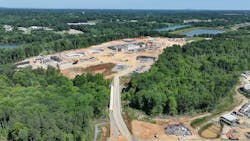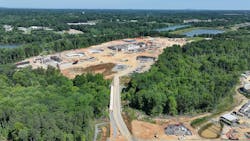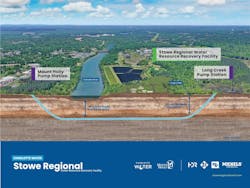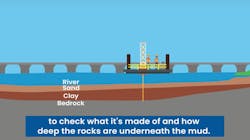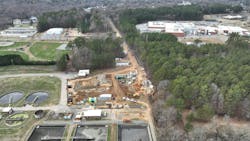Demystifying the engineering process of Charlotte Water's largest project yet
Planning for the future
North Carolina’s largest water utility is currently constructing the most sizable project in its history. Set on the peaceful banks of the Catawba River, Charlotte Water’s Stowe Regional Water Resource Recovery Facility (RWRRF) will treat up to 15 million gallons of wastewater per day when it opens in 2027 to meet the future demand of one of the fastest-growing regions in the country. The location of Stowe RWRRF in western Mecklenburg County will reduce the distance wastewater must be pumped for treatment. Currently, wastewater in this region is pumped 27 miles through an aging and extensive pumping system that would need to be expanded to provide additional capacity.
On the western side of the river, the cities of Belmont and Mount Holly also have faced growing pains, as well as more stringent environmental regulations, that would have required extensive and expensive upgrades to their existing municipal wastewater treatment plants. Based on the belief that the region’s water and wastewater resources are best managed regionally, Charlotte Water formed a partnership with the two cities with a plan to replace their aging facilities with new pump stations that would send wastewater flows to Stowe RWRRF.
“This consolidation process will reduce the number of wastewater treatment plant discharges that recycle treated water back into the Catawba River,” Charlotte Water Engineering Division Manager Nicole Bartlett said. “Stowe’s state-of-the-art cleaning and purification system also will release cleaner water back into the river, improving its water quality, while also minimizing any shoreline or wetland impacts from these plant discharges.”
Moreover, the high-tech Stowe RWRRF will use an enhanced settling process called densification to more effectively process and purify wastewater and meet heightened state and federal water quality standards.
“Stowe will be the first greenfield wastewater treatment plant in the country to use densification,” Bartlett added.
The Catawba River is one of the region’s most important natural resources. Running through western North and South Carolina, it serves as a primary source of drinking water, vital environmental resource and popular recreation space for kayaking, paddle boarding and fishing. Transporting wastewater flows from Mount Holly and Belmont to Charlotte Water’s collection and treatment system required the installation of wastewater pipelines, called force mains, under the Catawba River and its neighbor, Long Creek.
Drilling deep into the earth
With the governmental partnership in place, connecting these cities’ wastewater systems would become the next challenge. There were three locations where force mains needed to be installed under bodies of water for this project. The first set would travel a distance of 3,100 feet roughly 65 to 75 feet under the Catawba River and Long Creek to link the Mount Holly Pump Station to Charlotte Water’s Long Creek Pump Station. The second set would travel 1,100 feet about 75 feet under Long Creek to connect the Long Creek Pump Station to Stowe RWRRF. The third set will be installed in the future approximately 50 feet deep under a different section of the Catawba River to link the Belmont Pump Station with Charlotte Water’s Paw Creek Pump Station. Its distance will be determined once a final route is selected.
Horizontal directional drilling (HDD) is the industry-preferred method of installing pipelines under bodies of water for its minimal ground disturbance, which reduces environmental impacts. HDD is a commonly used technique where a tunnel is drilled deep into bedrock and is one of the safest ways to install pipelines. Skilled technicians use an electronic drill head to guide a drilling pipe as it bores an underground tunnel under the riverbed.
To design the HDD crossing, sound waves from a Bathymetric Survey were needed to measure and visualize the topography and elevations of the riverbed and its surrounding shorelines, as well as the depth to reach bedrock. Meanwhile, geotechnical investigations were used to identify the soil composition. To accomplish these tasks, a flat-deck boat about 25-feet long was equipped with surveying instruments and a small drill rig. Once the surface elevations were measured, soil samples were taken using a small drill contained within a metal tube.
“This work does not harm the environment and is safe to perform while the public enjoys recreational activities like boating and fishing,” Bartlett said.
Once rock samples were obtained using a drill, they were sent to the lab to be tested for hardness. This data was ultimately provided to the design and construction team to inform the HDD plan. The drilling process began with a small pilot hole bored into the bedrock, followed by progressively larger bores as the tunnel was reamed out.
Each tunnel was 12 inches wider than the pipe it would house. There are two 26-inch force mains connecting the Mount Holly and Long Creek Pump Stations, two 42-inch force mains connecting Long Creek Pump Station to Stowe RWRRF, and it is anticipated that two 22-inch force mains will connect the Belmont and Paw Creek Pump Stations. Two pipes were installed for each crossing to provide redundancy during maintenance tasks and high-flow events.
The force main material utilized is called high-density polyethylene pipe or HDPE pipe. The HDPE pipe is transported to the construction site in sections and fused using heat to form one long, continuous pipe. The HDPE pipe is pressure tested for leaks and passes a rigorous inspection before installation begins.
After installation, the pipe is inspected, and it is continuously monitored once in use. The force mains from Mount Holly to Long Creek and from Long Creek to Stowe RWRRF were completed in 2023. Work on the Belmont force mains is anticipated to begin within the next two years.
Charlotte Water will begin receiving Mount Holly’s wastewater flows in late 2024 or early 2025 at the Long Creek Pump Station. Once there, it will be treated at existing Charlotte Water facilities until Stowe RWRRF begins service in 2027. The Belmont Pump Station and Force Mains Project is anticipated to begin service around the same time. Belmont’s wastewater will initially be treated at other Charlotte Water facilities, until such a time in the future that Stowe RWRRF is expanded, and Paw Creek Pump Station is modified to send flow to Stowe RWRRF.
Reaching the next generation
Charlotte Water adopted a proactive approach to explain this highly technical project to the public. The organization sought to address any concerns about the potential impacts of drilling under the Catawba River.
Outreach began with the project’s Community Stakeholder Committee, which Charlotte Water formed at the onset of the Stowe RWRRF project in 2019 to understand the community’s needs, values and concerns. The committee consists of individuals who work, live and serve within the project community, including staff from neighboring schools, elected officials, residents, as well as representatives from the Catawba Riverkeeper, Catawba Lands Conservancy and Catawba Indian Nation.
Over the course of the project, collaborative relationships were established with local governments, agencies and nonprofit organizations providing a foundation of trust in Charlotte Water’s commitment to being an environmental steward.
Providing in-person engagement opportunities for the public is a critical component of Charlotte Water’s equitable approach to community involvement. The Catawba Riverkeeper hosts an annual celebration of the Catawba River called Riverfest in Belmont, and it takes place just north of the Belmont Pump Station. Charlotte Water participates in this event every year, presenting meeting boards that illustrate the HDD crossing under the river and the facility locations for the upcoming project in Belmont.
Likewise, Charlotte Water has formed ongoing partnerships with nearby schools to support Environmental, Science, Technology, Engineering and Math (ESTEM) educational programs and encourage students to pursue careers in ESTEM fields. Next door to Stowe RWRRF is Whitewater Middle School, a magnet school focused on science, technology, engineering and math (STEM) education. Charlotte Water has built a close relationship with this school, presenting visualizations of the HDD crossing and Stowe RWRRF at annual events like its Open House and Homecoming Game. Furthermore, at the school’s annual Career Fair, Charlotte Water and the project consultant team have a large presence to promote careers in engineering and construction, focusing on the variety of educational paths available for students to enter these careers. To build excitement around these occupational fields, drone videos of the Stowe project construction site are played on a loop throughout the fair.
Additionally, college students from Western Carolina University in Cullowhee, North Carolina and North Carolina Agricultural and Technical State University in Greensboro, North Carolina have taken field trips to the Stowe RWRRF construction site for hands-on learning experiences.
During those events, the project team shares presentations on the engineering and construction processes, along with information on workforce development programs. It is Charlotte Water’s honor to serve its community via efficient and ecofriendly wastewater treatment processes and educational outreach opportunities for years to come.
About the Author

Nicole Bartlett
Nicole Bartlett is a Division Manager within the Engineering Division at Charlotte Water, a department of the City of Charlotte. She is serving as the Project Manager for the Stowe RWRRF program. Bartlett has 17 years of experience in the water and wastewater industries and has served in regulatory, consulting and owner roles. She has managed both collaborative and traditional delivery projects of more than $500 million.

Will Shull
Will Shull is an Associate Vice President with HDR in the Charlotte office and serves as the Owner Advisor for Charlotte Water on the Stowe Program of projects. During his 12 years at HDR, Shull has primarily been engaged in collaborative delivery projects in water and wastewater treatment facilities. He currently serves as a Vice Chair of the new professional committee for the Water Collaborative Delivery Association.
